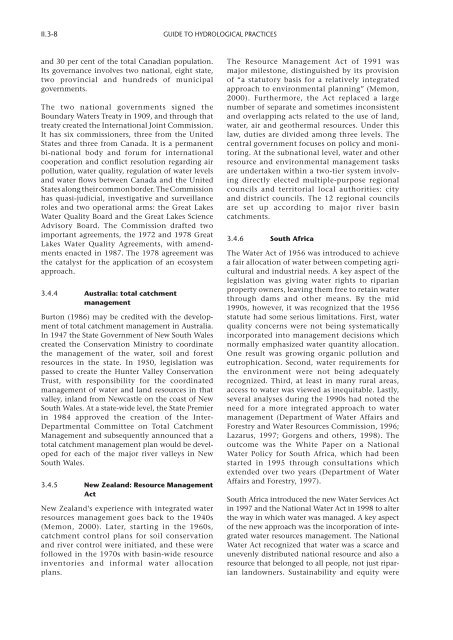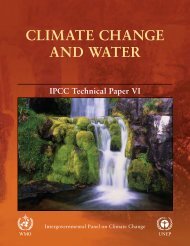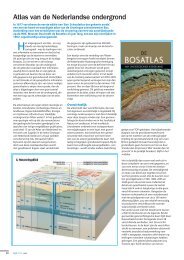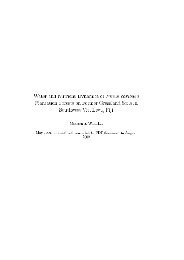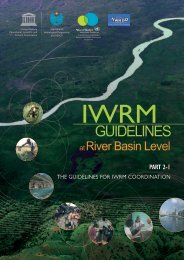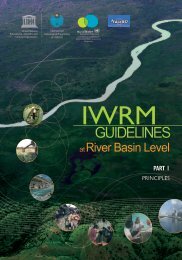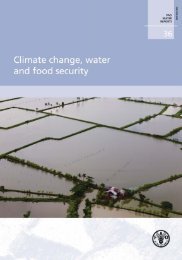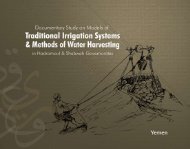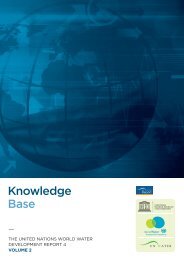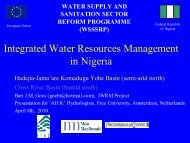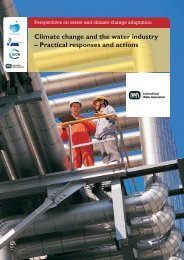Guide to Hydrological Practices, 6th edition, Volume II - Hydrology.nl
Guide to Hydrological Practices, 6th edition, Volume II - Hydrology.nl
Guide to Hydrological Practices, 6th edition, Volume II - Hydrology.nl
You also want an ePaper? Increase the reach of your titles
YUMPU automatically turns print PDFs into web optimized ePapers that Google loves.
<strong>II</strong>.3-8GUIDE TO HYDROLOGICAL PRACTICESand 30 per cent of the <strong>to</strong>tal Canadian population.Its governance involves two national, eight state,two provincial and hundreds of municipalgovernments.The two national governments signed theBoundary Waters Treaty in 1909, and through thattreaty created the International Joint Commission.It has six commissioners, three from the UnitedStates and three from Canada. It is a permanentbi-national body and forum for internationalcooperation and conflict resolution regarding airpollution, water quality, regulation of water levelsand water flows between Canada and the UnitedStates along their common border. The Commissionhas quasi-judicial, investigative and surveillanceroles and two operational arms: the Great LakesWater Quality Board and the Great Lakes ScienceAdvisory Board. The Commission drafted twoimportant agreements, the 1972 and 1978 GreatLakes Water Quality Agreements, with amendmentsenacted in 1987. The 1978 agreement wasthe catalyst for the application of an ecosystemapproach.3.4.4 Australia: <strong>to</strong>tal catchmentmanagementBur<strong>to</strong>n (1986) may be credited with the developmen<strong>to</strong>f <strong>to</strong>tal catchment management in Australia.In 1947 the State Government of New South Walescreated the Conservation Ministry <strong>to</strong> coordinatethe management of the water, soil and forestresources in the state. In 1950, legislation waspassed <strong>to</strong> create the Hunter Valley ConservationTrust, with responsibility for the coordinatedmanagement of water and land resources in thatvalley, i<strong>nl</strong>and from Newcastle on the coast of NewSouth Wales. At a state-wide level, the State Premierin 1984 approved the creation of the Inter-Departmental Committee on Total CatchmentManagement and subsequently announced that a<strong>to</strong>tal catchment management plan would be developedfor each of the major river valleys in NewSouth Wales.3.4.5 New Zealand: Resource ManagementActNew Zealand’s experience with integrated waterresources management goes back <strong>to</strong> the 1940s(Memon, 2000). Later, starting in the 1960s,catchment control plans for soil conservationand river control were initiated, and these werefollowed in the 1970s with basin-wide resourceinven<strong>to</strong>ries and informal water allocationplans.The Resource Management Act of 1991 wasmajor miles<strong>to</strong>ne, distinguished by its provisionof “a statu<strong>to</strong>ry basis for a relatively integratedapproach <strong>to</strong> environmental planning” (Memon,2000). Furthermore, the Act replaced a largenumber of separate and sometimes inconsistentand overlapping acts related <strong>to</strong> the use of land,water, air and geothermal resources. Under thislaw, duties are divided among three levels. Thecentral government focuses on policy and moni<strong>to</strong>ring.At the subnational level, water and otherresource and environmental management tasksare undertaken within a two-tier system involvingdirectly elected multiple-purpose regionalcouncils and terri<strong>to</strong>rial local authorities: cityand district councils. The 12 regional councilsare set up according <strong>to</strong> major river basincatchments.3.4.6 South AfricaThe Water Act of 1956 was introduced <strong>to</strong> achievea fair allocation of water between competing agriculturaland industrial needs. A key aspect of thelegislation was giving water rights <strong>to</strong> riparianproperty owners, leaving them free <strong>to</strong> retain waterthrough dams and other means. By the mid1990s, however, it was recognized that the 1956statute had some serious limitations. First, waterquality concerns were not being systematicallyincorporated in<strong>to</strong> management decisions whichnormally emphasized water quantity allocation.One result was growing organic pollution andeutrophication. Second, water requirements forthe environment were not being adequatelyrecognized. Third, at least in many rural areas,access <strong>to</strong> water was viewed as inequitable. Lastly,several analyses during the 1990s had noted theneed for a more integrated approach <strong>to</strong> watermanagement (Department of Water Affairs andForestry and Water Resources Commission, 1996;Lazarus, 1997; Gorgens and others, 1998). Theoutcome was the White Paper on a NationalWater Policy for South Africa, which had beenstarted in 1995 through consultations whichextended over two years (Department of WaterAffairs and Forestry, 1997).South Africa introduced the new Water Services Actin 1997 and the National Water Act in 1998 <strong>to</strong> alterthe way in which water was managed. A key aspec<strong>to</strong>f the new approach was the incorporation of integratedwater resources management. The NationalWater Act recognized that water was a scarce anduneve<strong>nl</strong>y distributed national resource and also aresource that belonged <strong>to</strong> all people, not just riparia<strong>nl</strong>andowners. Sustainability and equity were


